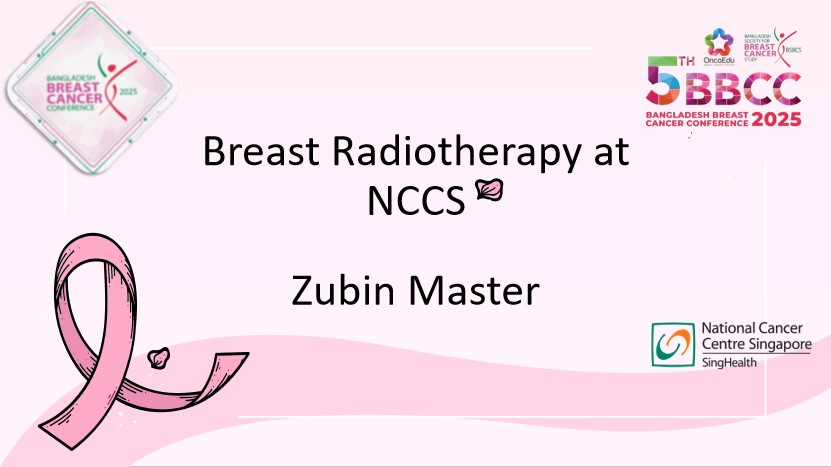Breast Radiotherapy at NCCS
Authors: Zubin Master
Institution: National Cancer Centre, Singapore
Introduction
This talk will provide an overview on the current standard of care for breast radiotherapy at NCCS, briefly covering 3D Conformal RT and Volumetric Modulated Arc Therapy, and will highlight the key planning techniques and considerations for these approaches. We will then transition to discussing the rationale for adopting proton radiotherapy in the management of breast cancer, and in particular, emphasize how the dosimetric properties of protons can improve target coverage, achieve improved cardiac and lung sparing, reduce contralateral breast exposure and reduce risks of secondary malignancies — especially in complex clinical scenarios, and we will briefly discuss our journey to start a proton breast trial and get proton therapy approved for the treatment of breast cancers in NCCS.
Methods
This talk will provide an overview on the current standard of care for breast radiotherapy at NCCS, briefly covering 3D Conformal RT and Volumetric Modulated Arc Therapy, and will highlight the key planning techniques and considerations for these approaches. We will then transition to discussing the rationale for adopting proton radiotherapy in the management of breast cancer, and in particular, emphasize how the dosimetric properties of protons can improve target coverage, achieve improved cardiac and lung sparing, reduce contralateral breast exposure and reduce risks of secondary malignancies — especially in complex clinical scenarios, and we will briefly discuss our journey to start a proton breast trial and get proton therapy approved for the treatment of breast cancers in NCCS.
Results
This talk will provide an overview on the current standard of care for breast radiotherapy at NCCS, briefly covering 3D Conformal RT and Volumetric Modulated Arc Therapy, and will highlight the key planning techniques and considerations for these approaches. We will then transition to discussing the rationale for adopting proton radiotherapy in the management of breast cancer, and in particular, emphasize how the dosimetric properties of protons can improve target coverage, achieve improved cardiac and lung sparing, reduce contralateral breast exposure and reduce risks of secondary malignancies — especially in complex clinical scenarios, and we will briefly discuss our journey to start a proton breast trial and get proton therapy approved for the treatment of breast cancers in NCCS.
Conclusion
This talk will provide an overview on the current standard of care for breast radiotherapy at NCCS, briefly covering 3D Conformal RT and Volumetric Modulated Arc Therapy, and will highlight the key planning techniques and considerations for these approaches. We will then transition to discussing the rationale for adopting proton radiotherapy in the management of breast cancer, and in particular, emphasize how the dosimetric properties of protons can improve target coverage, achieve improved cardiac and lung sparing, reduce contralateral breast exposure and reduce risks of secondary malignancies — especially in complex clinical scenarios, and we will briefly discuss our journey to start a proton breast trial and get proton therapy approved for the treatment of breast cancers in NCCS.
